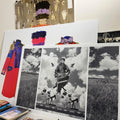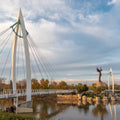What is Western Art?
By Chadd Scott on
Cowboys, cattle, and cactus. Buffalo, bears, and bluebonnets. Mountains, valleys, and mesas.
And horses.
What is Western art?
What is this thing it’s safe to say everyone reading this has a deep love and passion for?
An exhibition of Laura Aguilar’s photography at the Phoenix Art Museum has me thinking more deeply about that question than ever before.
Aguilar (1959–2018) is from Southern California. That’s western.

Laura Aguilar, Center #98, 2000-2001. Gelatin silver print. Copyright Laura Aguilar Trust of 2016.
The pictures she’s best known for feature Southwestern landscapes. That’s western.
Large format black and white images honoring the land. That’s western.
She’s also lesbian and Chicana, two communities rarely represented in Western art either as subject or maker.
Further confounding standards, Aguilar placed herself in her Southwestern landscape photos. Her large, brown body. The sort of body that has never been welcome in any genre of art.
In Aguilar’s pictures, the artist often doubles as a landscape feature, a bolder or outcropping.
Dorothea Lange and Ansel Adams never did that.
Yet Aguilar tributes these western places as surely as Maynard Dixon or the Taos Society of Artists ever did. She found a serenity in the desert, a comfort, a home, just like Georgia O’Keeffe.

Laura Aguilar, Grounded #105, 2006-2007, printed 2018. Inkjet print. Copyright Laura Aguilar Trust of 2016.
And she shared those places and feelings tenderly, beautifully, in her pictures.
What is Western art?
Perhaps the better question is “who is Western art?”
Laura Aguilar is Western art to me; not only Western – she transcends the genre as surely as she’s part of it – but Western also, same as O’Keeffe wasn’t just a Western artist, but an essential American artist, an essential Modern artist. Like Marsden Hartley or Raymond Jonson or Agnes Pelton. Like Lange. Like Dixon.
Like Leon Polk Smith (1906–1996).
Smith was born in Indian Territory one year before it became the state of Oklahoma.
That’s pretty western.
He did some farming and ranching to help out the family.
Western.
But that life wasn’t for him, and he knew it. He went off to college in New York in the late 1930s, eventually moving there for good in the 40s.
Not western.
While Smith was influenced by early 20th century European avant garde art movements like Cubism and Surrealism and he took a real shine to Piet Mondrian – not western – his paintings also connect with the colors and patterns of Southern Plains beadwork, ribbon work, and painted hides.
He spent time in New Mexico.
Super western.

Laura Aguilar, Grounded #106, 2006-2007, printed 2018. Inkjet print. Copyright Laura Aguilar Trust of 2016.
“I grew up in the Southwest, where the colors in nature were pure and rampant, and where my Indian neighbors and relatives used color to vibrate and shock,” Smith said.
Smith has Cherokee ancestry, but never attempted to consider himself a “Native” artist.
Smith would go on to renown as a Modernist painter and one of the founders of the Hard-edge Painting Movement, an art form of the late 1950s and ’60s emphasizing geometric forms in bright colors.
No one considers Hard-edge Painting “western,” although the Denver Art Museum has a fantastic Leon Polk Smith Hard-edge painting hung prominently in its Western Art galleries and it looks right at home.
I most recently found Smith’s work in a solo show at Lisson Gallery in Chelsea. The chic white cube space in Manhattan’s most fashionable contemporary art neighborhood couldn’t be further from anything considered “western.”
Yet hanging there on the wall was an undeniably Western painting, Lariat (1938).
Is Leon Polk Smith a “Western” artist? Yeah.
Not just a Western artist, but also a Western artist.
Living in New York and exploring other art movements doesn’t preclude someone from being a Western artist any more than living in Florida and writing about all types of art – as I do – precludes me from writing about Western art or preclude someone living in Chicago and collecting all types of art from collecting Western art.
It’s a feeling, an appreciation, a respect, and interest in the West which makes a Western artist or writer or collector, not their mailing address.
![Leon Polk Smith, Lariet [Lariat], 1950. Marker on paper; 42.2 x 35.6 cm, 16 58 x 14 in. Courtesy of Lisson Gallery.](https://cdn.shopify.com/s/files/1/0699/2881/2852/files/Leon-Polk-Smith-1.jpg?v=1706642835)
Leon Polk Smith, Lariet [Lariat], 1950. Marker on paper; 42.2 x 35.6 cm, 16 58 x 14 in. Courtesy of Lisson Gallery.
It’s not marriage, you don’t have to pick just one.
I find Western art to be most exciting when it’s considered through the widest lens possible. A lens that includes Chinese and African painters, African American sculptors, Chicana photographers like Aguilar, Okie painters like Smith who couldn’t wait to get out of there and go to New York.
And of course – first and foremost – artists with ancestry indigenous to the region; the original Western artists.
The West has room for them all. Us all.
Shoot, even Andy Warhol was fascinated by the West and created Western art. Did you know he collected cowboy boots and routinely wore them?
The West is big, and the bigger and more inclusive the boundaries of Western art are allowed to become, the better it will be.



